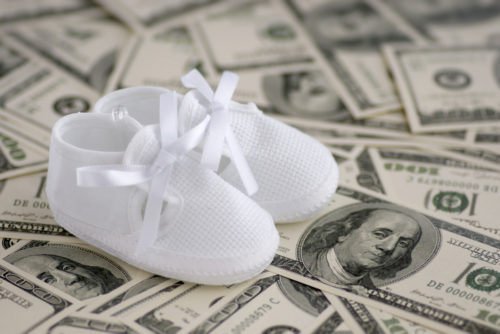How much it costs to have a baby depends on where you live and the choices that you make during pregnancy and while raising your child. A baby’s needs are different during each stage of their development, so costs can vary from month to month and year to year.
If you know what to expect during each phase of pregnancy and childhood development, you can build a financial plan to ensure that you have the means to care for your child.
Some people might not want to think about money when deciding whether or not to have children. However, the cost of raising a baby is part of the equation that you need to consider when starting a family. Whether they admit it or not, money is a major variable in the family planning process for many prospective parents.
Table of Contents
How Does Money Affect Family Planning
According to the Center for Disease Control, 2018 saw the lowest number of annual births in the United States since 1986. The birth rate has declined in each of the last four years. Though there could be a number of causes for this drop in births, economic considerations likely play a part.
Exactly how much does it cost to raise a baby? The U.S. Department of Agriculture estimates that the cost of raising a child from birth until they leave the home approaches $300,000 (with adjustments for inflation).
The Cost of Having a Baby
$300,000 is not a one-time price tag; you spread the cost out over 18 years and nine months. The first phase of budgeting for a baby is paying for pregnancy and delivery. These costs can vary significantly depending on the health coverage available in your state or your employer’s benefits package and maternity leave policies.
Overall, prenatal care should cost about $2,000, and birth without complications is between $10,000 and $15,000. You need to be aware of the factors that can affect these costs.
Pregnancy Costs
Out-of-pocket costs during pregnancy can vary depending on your insurance coverage. Pregnant women make regular visits to their physician during the gestation period. Without insurance, these visits can add up to about $2,000 over nine months. This price includes ultrasounds to check the baby’s development, blood tests, and regular exams to ensure the health of the mother.
If the doctor suspects abnormalities or finds evidence of health problems during routine exams, they may order additional tests. Diagnostic procedures such as chorionic villus sampling or amniocentesis can double the out-of-pocket costs for expectant families without health insurance.
The Affordable Care Act says that insurers cannot turn down applicants because of pre-existing conditions, including pregnancy. Expectant families who lack insurance coverage can get a policy to help handle the costs associated with pregnancy and birth. Additionally, some states provide Medicare coverage or have similar assistance programs for people with low income. These offerings often have specific coverage for pregnant mothers.
Maternity Leave
Maternity leave is an overlooked issue. Pregnancy discrimination can lead to mothers losing their job while pregnant or after giving birth. The New York Times reported on numerous women who sued their employers because of pregnancy discrimination. The Times story also pointed to a study by the University of Massachusetts, Amhurst, which showed that new mothers have their hourly earnings reduced by 4%, on average, when they return to work.
Even if your workplace is supportive, you may not be able to work during the last months of your pregnancy and for a period of time after giving birth. This could lead to lost wages and increase the financial strain on your family’s other income earner.
When figuring out the cost of pregnancy, you should research your employer’s maternity leave policies. Some companies offer paid time off during pregnancy, while others promise to hold your position for you for a period of time during pregnancy and birth.
Technically, employers need to provide unpaid leave for employees who are pregnant or have just given birth. The rights of new parents are protected in this way because of the Family and Medical Leave Act (FMLA). If you work for a company that has more than 50 employees, the FMLA requires your employer to keep your job for you for up to three months. You need to have worked for the company for at least one year.
Delivery
Delivery is the most expensive part of a pregnancy, even if you do not experience complications. An article published on the BBC website showed that the United States is the most expensive place in the world to give birth. On average, a U.S. hospital charges $10,000 for a standard vaginal birth and $15,000 for a cesarean section. These prices can increase dramatically if you need additional services or if there are complications during the delivery.
As it does during pregnancy, health insurance can limit costs associated with the delivery. Even policies with high deductibles can cover unforeseen expenses due to complications.
How Much Does a Baby Cost per Month?
The next phase of your baby-money planning process involves figuring how much it costs to raise a child once they get home from the hospital. During this phase, your financial focus changes to providing the child with everything that they need for healthy development.
How much does a baby cost per year? Back in 2015, the U.S. Department of Agriculture published a report that estimated that a couple could expect to spend between $12,350 and $13,900 annually to care for a child. That works out to between $1,029 and $1,158 per month, on average. These figures include food, healthcare, housing, transportation, education, and other expenses. However, the amount does not include college savings or pregnancy and birth costs.
The USDA study says that the overall costs can vary by region. For example, the average price of raising a child is 27% lower in rural areas than in major urban centers.
Here is a breakdown of the different costs associated with raising a child from birth through the age of 18.
Food and Clothing
Clothing can be a major expense during childhood because children grow and develop quickly. A child’s size can change each year, meaning that clothing and shoes may only last for one season. For example, you may need to purchase a new coat and boots each winter for a growing child.
Food costs can also vary depending on your diet and the number of people for whom you cook. At some points in a child’s development, they’ll have specific nutritional needs. For example, if you feed your baby formula, you can expect to spend about $35 per week. Once a child starts to eat solid foods, you may spend $3 to $4 per day on baby food jars or on ingredients to make your own baby food.
Unless they have special dietary needs, older kids can eat the same food as the other members of their family. Children who are going through a rapid growth phase may eat more food than usual, which can add to costs. Additionally, school-aged children spend between $2 and $3 per day on school lunch or the ingredients of an equivalent bagged lunch.
Diapers and Hygiene Items
Young babies need diapers and related hygiene products such as wipes, baby shampoo, powder, and diaper rash ointment. The National Diaper Bank Network estimates that parents spend between $70 and $80 per month on diapers alone. This estimate is for disposable diapers. The cost of a diaper service that delivers and lauders cloth diapers is comparable to the monthly price of disposable diapers. Wipes and miscellaneous powders, lotions, and ointments add about $20 per month to the total cost of the baby’s hygiene.
Baby Gear
Diapers, clothing, food, and hygiene supplies are recurring costs. You also have one-time costs associated with having a baby. For example, a baby needs a car seat, a crib, a stroller, a bassinet, and assorted play items, swings, and toys. WebMD estimates that these one-off costs can top $3,000. This estimate may seem high, but you should understand that you need to purchase products that meet safety and quality standards. Your state law can actually require you to buy a car seat that meets safety requirements.
Furniture costs decrease as your child grows. You will still need to purchase beds that can accommodate them as they grow, however, older children do not need as many pieces of specialized equipment as babies.
Health Insurance
Health insurance costs can vary depending on your current plan or the coverage that your employer or a state program offers you. If you have family healthcare coverage, your premiums will increase when you add a newborn to your policy. This is the case whether you have a private plan or if your employer deducts your premium.
Under current laws, parents have 30 days to add a child to their health insurance plan. Regulations also state that children cannot be denied coverage because of health complications.
Childcare
Childcare costs can vary depending on your familial situation, employment plans, and other variables. On average, however, childcare is one of the most expensive aspects of raising a child. Costs can run between $800 and $1200 per month.
Large segments of the population find prices unaffordable. A Care.com survey showed that half of all families spend at least 15% of their monthly income on childcare. The study also showed that daycare centers and after-school programs were cheaper than in-home care.
Most parents do not consider childcare when budgeting the cost of raising a baby. 70% of parents told Care.com that childcare was the most significant unexpected expense that they encountered.
Emergency Costs
Emergency costs will come up during a child’s early life. You can prepare for some emergencies. For example, health insurance can help you handle unforeseen medical expenses. However, insurance does not cover other emergencies, such as taking an unexpected trip for a family bereavement, or hiring a babysitter at the last minute because of a work-related emergency.
You can also include costs related to your child’s participation in activities at school or in the community among unexpected expenses. While there is no way to plan for these expenses or guess how much you might need, you can create an emergency fund to deal with these extra costs.
Saving for a Baby: How Much You Need
The costs of giving birth and raising a child vary depending on where you live, your insurance policy, and other factors. Here are the items you should consider when figuring out how much it costs to raise a baby.
Summary of Costs
- Medical services during pregnancy. These services are around $2,000 without health insurance coverage. Costs can be higher if you experience complications. However, health insurance coverage, even if purchased after you become pregnant, can significantly lower this amount.
- Delivery. The average cost of giving birth is between $10,000 and $15,000. Again, insurance coverage can lower these expenses.
- Diapers and other hygiene items (for two to three years). These products are necessary, and the price is about $100 per month. Once your child is toilet trained, however, diaper expenses disappear.
- Initial baby gear and furnishings. You will incur these expenses, which can total as much as $3,000, as you prepare for the baby’s arrival. Since you need new products that provide the necessary safety features for your baby, this is one area where it can be difficult to seek discounts or save money.
- Health insurance and healthcare. If you have health insurance, you can add a newborn to your policy. Costs vary depending on your employer’s benefits package, the state in which you live, and the level of your insurance coverage. Since children need regular checkups and immunizations, having health insurance is almost always cheaper than paying for healthcare out-of-pocket.
- Childcare. Childcare expenses can reach $800-$1200 per month. You can, however, take steps to lower these costs by finding cheaper childcare options, adjusting your work schedule, or relying on family members for childcare.
- Unexpected costs and emergencies. You can create a fund to deal with these expenses by either saving a small amount monthly, or, if possible, depositing money into a savings account and keeping it there to deal with emergencies.
Save for the Initial Costs of Having a Baby
Initial costs of having a baby include pregnancy and delivery and also baby gear and equipment. These are one-time expenses that you need to save for (or cover with health insurance). Ideally, you would save the necessary money before you try to start a family.
If you would like to create a financial buffer, you can also save extra money to cover child-raising costs for several months. This way, in the event of employment changes or other unforeseen issues, you can still provide the baby with anything that it needs.
Create a Monthly Budget for Recurring Baby Costs
Food, clothing, insurance, and other regular expenses can become a part of your monthly budget. You can create a plan that includes all these necessary costs. Once you have all the necessities accounted for, you can perform research to find ways to lower these costs. For example, you could save by buying diapers or formula in bulk or seek out generic brands that offer similar quality for less.
Build an Emergency Fund to Cover Unexpected Baby Expenses
If you have time to prepare, you can set up an emergency fund by saving a reasonable amount of money from each paycheck. If you can consistently save the same, realistic amount each month, your emergency fund will grow over time.
Advice about the amount of money that you need to save in an emergency fund varies. A common goal is $1,000. After you achieve this, you can continue to build your emergency fund, or you can refocus your savings efforts on a college or retirement fund. Ideally, you can keep saving the same amount from your paycheck each month. If you start saving early, a modest amount can grow into a substantial college fund or retirement account.
Having a child will require you to make changes to your finances. However, if you can plan ahead, define all your one-time and recurring costs, and create a realistic budget, you can make the adjustments that you need to afford the necessities associated with raising a child.
Image Source: https://depositphotos.com/





